Procurement 101: Supplier Consolidation – Practical steps, challenges and solutions

Table of Contents

In the dynamic landscape of industrial procurement, strategic agility and foresight stand as pillars of success. For procurement managers in the industrial machinery sector, supplier consolidation emerges as a pivotal strategy to secure a competitive edge and ensure operational efficiency. This guide offers an in-depth exploration of supplier consolidation, highlighting its significance, practical steps for implementation, challenges encountered, and solutions to navigate these obstacles.
What is Supplier Consolidation in the Manufacturing Industry
Supplier consolidation is a strategic approach in supply chain management where a company reduces the number of suppliers it works with to streamline its procurement process. This practice involves selecting fewer suppliers for various components or services, focusing on building stronger, more reliable partnerships with a select group of vendors. The primary goal of supplier consolidation is to achieve greater efficiency, reduce costs, and enhance product quality through closer collaboration and improved communication with key suppliers.
The Importance of Supplier Consolidation
In the competitive landscape of the manufacturing industry, supplier consolidation plays a crucial role in maintaining a lean and agile supply chain. By consolidating suppliers, companies can significantly reduce complexity and variability in their supply chain, leading to cost savings from bulk purchasing, reduced administrative overhead, and minimized risk of supply chain disruptions.
Moreover, this approach facilitates better quality control, as working closely with fewer suppliers enables more stringent quality checks and a deeper understanding of each other’s capabilities and standards. Ultimately, supplier consolidation strengthens the supply chain, fosters innovation through collaborative relationships, and positions companies to respond more effectively to market demands and changes.
6 Steps for Effective Supplier Consolidation
- Assessment of Current Supplier Base:
Begin with a comprehensive review of your current suppliers. Evaluate their performance, reliability, cost structures, and the strategic value they bring to your organization. - Define Consolidation Objectives:
Set clear, measurable goals for your consolidation effort. Objectives might include cost reduction targets, efficiency improvements, or quality enhancement goals. - Strategic Selection of Suppliers:
Based on the assessment, select suppliers that align with your strategic objectives and have the capacity to meet your needs at scale. - Negotiate Contracts and Terms:
With a consolidated supplier list, renegotiate terms to reflect the increased volume and strategic partnership. - Implement and Monitor:
Roll out the consolidation plan, closely monitoring the transition to ensure minimal disruption. Regularly review supplier performance against the set KPIs. - Continuous Improvement:Use feedback and performance data to continually refine and improve the supplier base.
Challenges and Solutions in Supplier Consolidation
1.The process of assessing the current supplier base is complex and time-consuming.
Challenges:
- Properly analyzing and evaluation suppliers from multiple perspectives
- Spending most of your time and resources meeting immediate sourcing deadlines, leaving no time to carefully analyze current suppliers and sourcing costs.
Solutions:
- Leverage tools and technologies to compare suppliers on multiple criteria at the part level.
- Evaluate suppliers based not only on historical purchase price, but also on lead time, quality data, and other key criteria unique to your company.
2. Supplier Relationship Management and Risk Mitigation
Challenges:
- The reduction in the number of suppliers can lead to vulnerabilities due to over-reliance on a few key suppliers.
- Resistance from suppliers worried about changes affecting their margins or increasing operational expectations.
Solutions:
- Ensure suppliers have strong risk management practices in place; adopt dual-sourcing strategies for essential components to reduce dependency risks.
- Highlight the mutual benefits of consolidation, such as improved demand forecasting and opportunities for operational and growth synergies, to overcome resistance.
3. Implementation Efficiency and Continuous Improvement
Challenges:
- The initial phase of implementing consolidation strategies might disrupt supply and operations.
- Complacency and resistance to change can stall ongoing improvement and adaptation efforts.
Solutions:
- Develop contingency plans and maintain open, effective communication with suppliers to swiftly tackle any arising issues.
- Cultivate a culture of continuous improvement and innovation within the team and among suppliers to ensure the long-term success of consolidation efforts.
3. Implementation Efficiency and Continuous Improvement
Challenges:
- The initial phase of implementing consolidation strategies might disrupt supply and operations.
- Complacency and resistance to change can stall ongoing improvement and adaptation efforts.
Solutions:
- Develop contingency plans and maintain open, effective communication with suppliers to swiftly tackle any arising issues.
- Cultivate a culture of continuous improvement and innovation within the team and among suppliers to ensure the long-term success of consolidation efforts.
How to revolutionize Supplier Consolidation leveraging AI solution
In the realm of supplier consolidation, it’s easy to tout the benefits of streamlining operations and cutting costs, but actually implementing these changes is another story. This case study explores how one of our customers revolutionized the supplier consolidation process by leveraging an AI solution.
- Company type: Metalworking machinery and equipment.
- Product: Band saw, drilling machine and processing line system
- Company size: Annual revenue of $50M and 200 employees
This company, specializing in the production of band saws, drilling machines, and processing line systems, has encountered challenges in their procurement process. With a product range that includes 30 models, each unit comprising 1,000-2,000 parts, the procurement team faced difficulties in supplier coordination and selection. The lack of knowledge sharing among buyers and the absence of regular competitive bidding were significant hurdles.
To overcome these challenges, the company implemented CADDi Drawer, an AI based Drawings Search Software that enables the grouping and analysis of drawings by material, surface treatment, and processing methods. This implementation has led to a 1% reduction in purchasing costs and shifted the focus of cost reduction activities from biannual to monthly efforts.
Key issues included the insufficient time allocated for sourcing custom-designed parts, a focus on cost reductions for standard parts during new product development, and a strong commitment from management to company-wide cost reduction and digital transformation. The procurement director played a crucial role in driving cost improvements and decided to pursue centralized purchasing despite the associated risks. The adoption of Drawer has facilitated better supplier selection and improved coordination among buyers, resulting in cost savings and more proactive efforts in cost reduction activities.
Concluding Insights: Mastering Supplier Consolidation
Supplier consolidation is not merely a tactical approach to reduce costs; it’s a strategic initiative that enhances supply chain agility, efficiency, and competitiveness. By understanding and navigating the challenges involved in supplier consolidation, procurement managers can unlock significant value for their organizations. This journey requires careful planning, strategic foresight, and a commitment to continuous improvement.
Engaging Further with CADDi
While this guide aims to provide a comprehensive overview of supplier consolidation, the landscape of industrial procurement is ever-evolving. Staying informed and engaged with platforms that offer specialized procurement solutions, like CADDi Drawer can provide the tools and insights necessary to navigate these complex waters successfully.
Similarity search of part drawings
CADDi Drawer’s similarity search function allows for the identification of which categories should be consolidated with which suppliers, based on price information and supplier information for each part category.
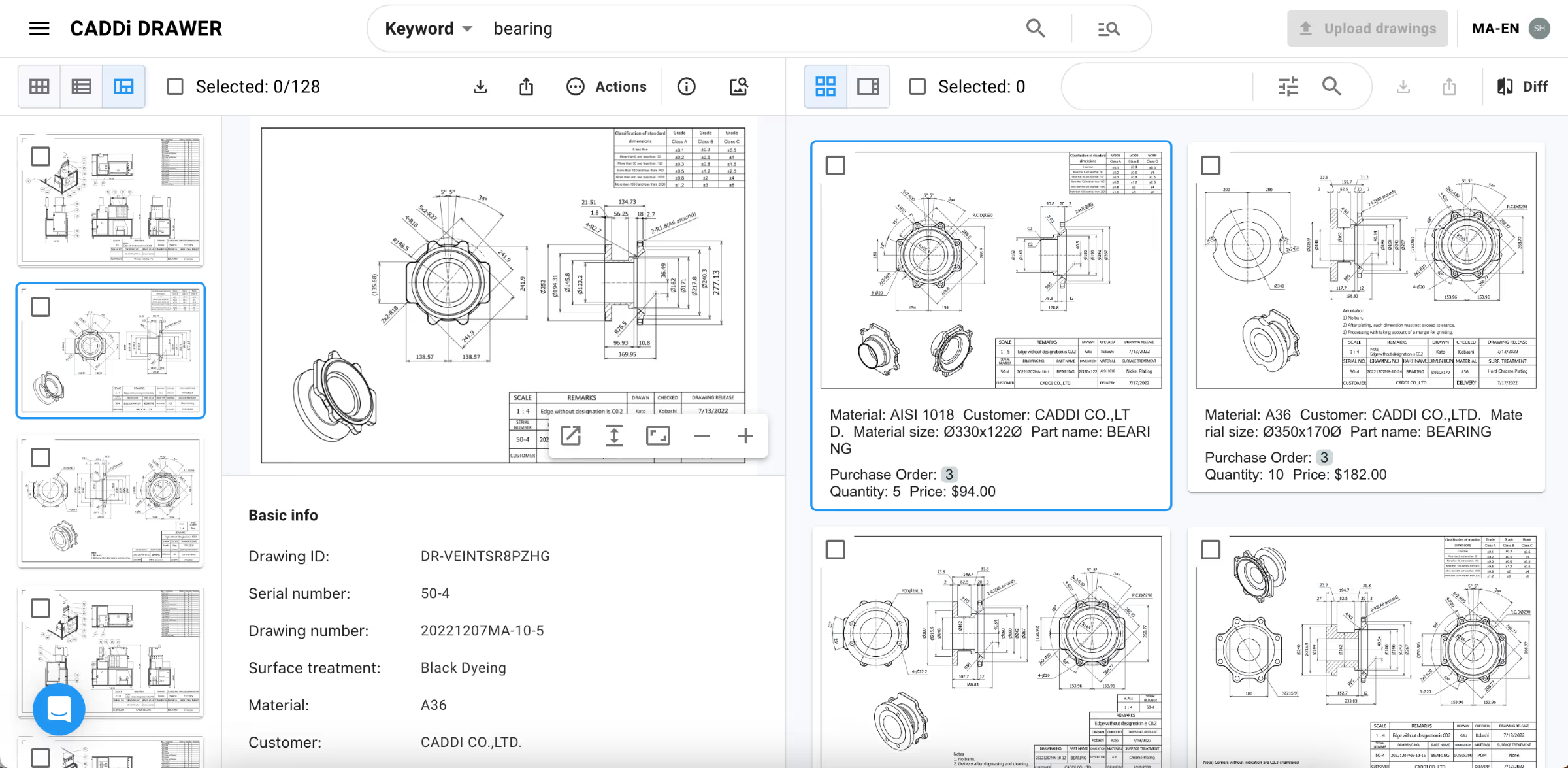
Streamline activities in the procurement process
The following features enable you to streamline the time-consuming tasks of data collection and organization in procurement operations.
- Price data and supplier information can be automatically linked to each drawing and can also be exported together.
- By using keyword searches combined with similarity searches, the time spent searching for drawings and data in procurement tasks can be reduced.
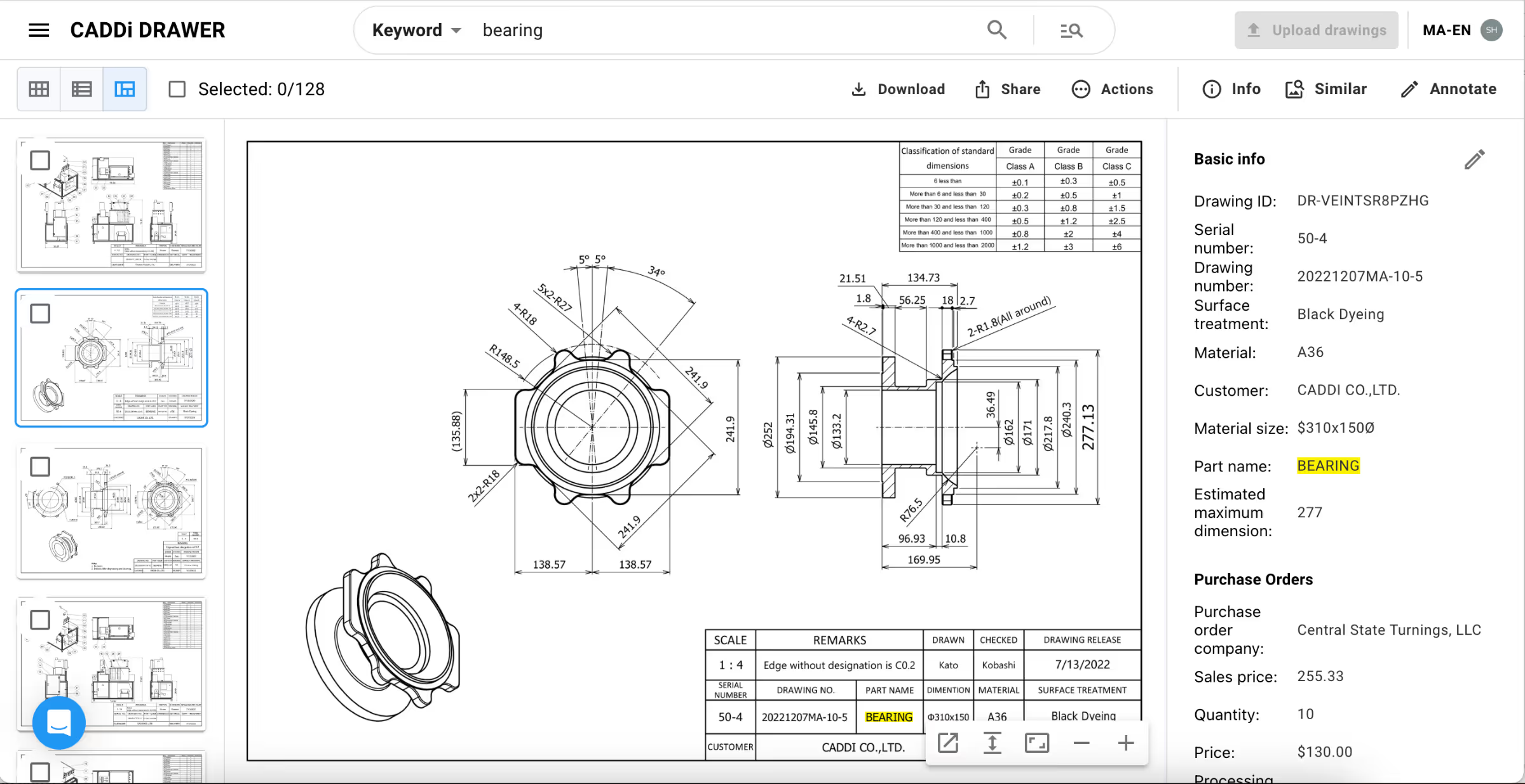
In the dynamic landscape of industrial procurement, strategic agility and foresight stand as pillars of success. For procurement managers in the industrial machinery sector, supplier consolidation emerges as a pivotal strategy to secure a competitive edge and ensure operational efficiency. This guide offers an in-depth exploration of supplier consolidation, highlighting its significance, practical steps for implementation, challenges encountered, and solutions to navigate these obstacles.
What is Supplier Consolidation in the Manufacturing Industry
Supplier consolidation is a strategic approach in supply chain management where a company reduces the number of suppliers it works with to streamline its procurement process. This practice involves selecting fewer suppliers for various components or services, focusing on building stronger, more reliable partnerships with a select group of vendors. The primary goal of supplier consolidation is to achieve greater efficiency, reduce costs, and enhance product quality through closer collaboration and improved communication with key suppliers.
The Importance of Supplier Consolidation
In the competitive landscape of the manufacturing industry, supplier consolidation plays a crucial role in maintaining a lean and agile supply chain. By consolidating suppliers, companies can significantly reduce complexity and variability in their supply chain, leading to cost savings from bulk purchasing, reduced administrative overhead, and minimized risk of supply chain disruptions.
Moreover, this approach facilitates better quality control, as working closely with fewer suppliers enables more stringent quality checks and a deeper understanding of each other’s capabilities and standards. Ultimately, supplier consolidation strengthens the supply chain, fosters innovation through collaborative relationships, and positions companies to respond more effectively to market demands and changes.
6 Steps for Effective Supplier Consolidation
- Assessment of Current Supplier Base:
Begin with a comprehensive review of your current suppliers. Evaluate their performance, reliability, cost structures, and the strategic value they bring to your organization. - Define Consolidation Objectives:
Set clear, measurable goals for your consolidation effort. Objectives might include cost reduction targets, efficiency improvements, or quality enhancement goals. - Strategic Selection of Suppliers:
Based on the assessment, select suppliers that align with your strategic objectives and have the capacity to meet your needs at scale. - Negotiate Contracts and Terms:
With a consolidated supplier list, renegotiate terms to reflect the increased volume and strategic partnership. - Implement and Monitor:
Roll out the consolidation plan, closely monitoring the transition to ensure minimal disruption. Regularly review supplier performance against the set KPIs. - Continuous Improvement:Use feedback and performance data to continually refine and improve the supplier base.
Challenges and Solutions in Supplier Consolidation
1.The process of assessing the current supplier base is complex and time-consuming.
Challenges:
- Properly analyzing and evaluation suppliers from multiple perspectives
- Spending most of your time and resources meeting immediate sourcing deadlines, leaving no time to carefully analyze current suppliers and sourcing costs.
Solutions:
- Leverage tools and technologies to compare suppliers on multiple criteria at the part level.
- Evaluate suppliers based not only on historical purchase price, but also on lead time, quality data, and other key criteria unique to your company.
2. Supplier Relationship Management and Risk Mitigation
Challenges:
- The reduction in the number of suppliers can lead to vulnerabilities due to over-reliance on a few key suppliers.
- Resistance from suppliers worried about changes affecting their margins or increasing operational expectations.
Solutions:
- Ensure suppliers have strong risk management practices in place; adopt dual-sourcing strategies for essential components to reduce dependency risks.
- Highlight the mutual benefits of consolidation, such as improved demand forecasting and opportunities for operational and growth synergies, to overcome resistance.
3. Implementation Efficiency and Continuous Improvement
Challenges:
- The initial phase of implementing consolidation strategies might disrupt supply and operations.
- Complacency and resistance to change can stall ongoing improvement and adaptation efforts.
Solutions:
- Develop contingency plans and maintain open, effective communication with suppliers to swiftly tackle any arising issues.
- Cultivate a culture of continuous improvement and innovation within the team and among suppliers to ensure the long-term success of consolidation efforts.
3. Implementation Efficiency and Continuous Improvement
Challenges:
- The initial phase of implementing consolidation strategies might disrupt supply and operations.
- Complacency and resistance to change can stall ongoing improvement and adaptation efforts.
Solutions:
- Develop contingency plans and maintain open, effective communication with suppliers to swiftly tackle any arising issues.
- Cultivate a culture of continuous improvement and innovation within the team and among suppliers to ensure the long-term success of consolidation efforts.
How to revolutionize Supplier Consolidation leveraging AI solution
In the realm of supplier consolidation, it’s easy to tout the benefits of streamlining operations and cutting costs, but actually implementing these changes is another story. This case study explores how one of our customers revolutionized the supplier consolidation process by leveraging an AI solution.
- Company type: Metalworking machinery and equipment.
- Product: Band saw, drilling machine and processing line system
- Company size: Annual revenue of $50M and 200 employees
This company, specializing in the production of band saws, drilling machines, and processing line systems, has encountered challenges in their procurement process. With a product range that includes 30 models, each unit comprising 1,000-2,000 parts, the procurement team faced difficulties in supplier coordination and selection. The lack of knowledge sharing among buyers and the absence of regular competitive bidding were significant hurdles.
To overcome these challenges, the company implemented CADDi Drawer, an AI based Drawings Search Software that enables the grouping and analysis of drawings by material, surface treatment, and processing methods. This implementation has led to a 1% reduction in purchasing costs and shifted the focus of cost reduction activities from biannual to monthly efforts.
Key issues included the insufficient time allocated for sourcing custom-designed parts, a focus on cost reductions for standard parts during new product development, and a strong commitment from management to company-wide cost reduction and digital transformation. The procurement director played a crucial role in driving cost improvements and decided to pursue centralized purchasing despite the associated risks. The adoption of Drawer has facilitated better supplier selection and improved coordination among buyers, resulting in cost savings and more proactive efforts in cost reduction activities.
Concluding Insights: Mastering Supplier Consolidation
Supplier consolidation is not merely a tactical approach to reduce costs; it’s a strategic initiative that enhances supply chain agility, efficiency, and competitiveness. By understanding and navigating the challenges involved in supplier consolidation, procurement managers can unlock significant value for their organizations. This journey requires careful planning, strategic foresight, and a commitment to continuous improvement.
Engaging Further with CADDi
While this guide aims to provide a comprehensive overview of supplier consolidation, the landscape of industrial procurement is ever-evolving. Staying informed and engaged with platforms that offer specialized procurement solutions, like CADDi Drawer can provide the tools and insights necessary to navigate these complex waters successfully.
Similarity search of part drawings
CADDi Drawer’s similarity search function allows for the identification of which categories should be consolidated with which suppliers, based on price information and supplier information for each part category.

Streamline activities in the procurement process
The following features enable you to streamline the time-consuming tasks of data collection and organization in procurement operations.
- Price data and supplier information can be automatically linked to each drawing and can also be exported together.
- By using keyword searches combined with similarity searches, the time spent searching for drawings and data in procurement tasks can be reduced.

Ready to see CADDi Drawer in action? Get a personalized demo.
Subscribe to our Blog!
Related Resources


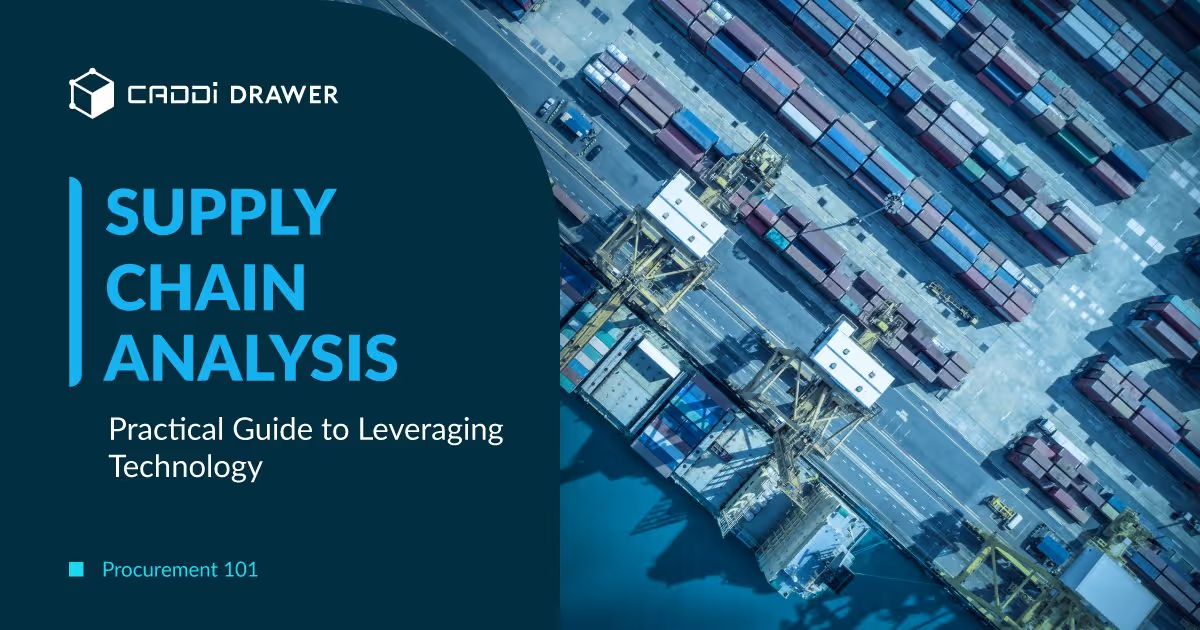



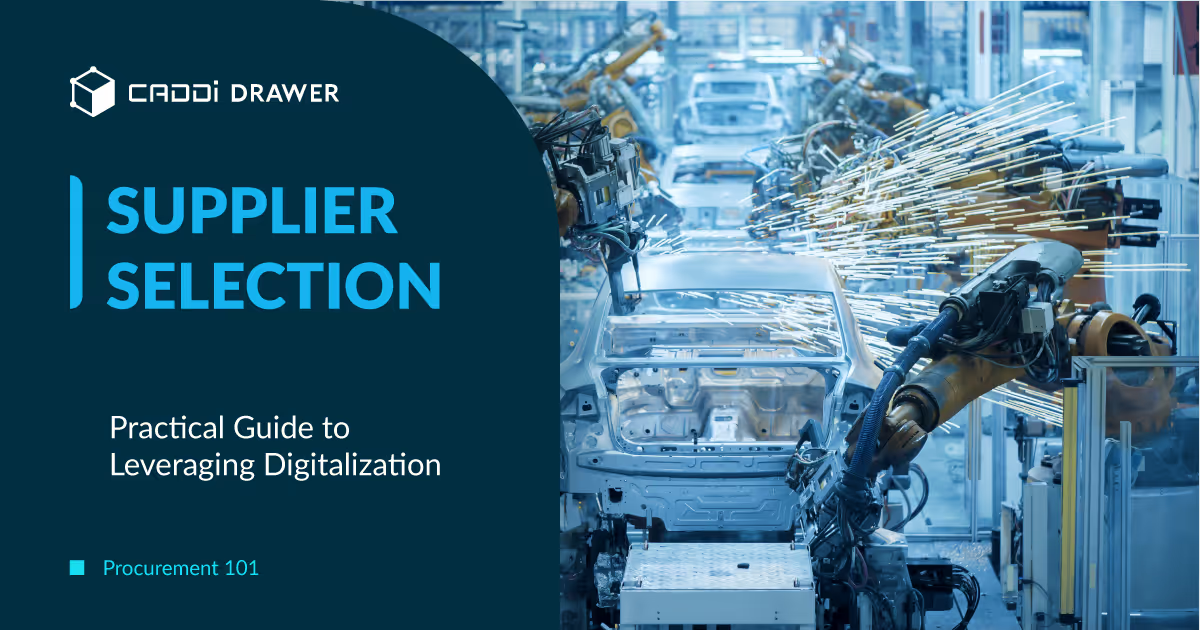

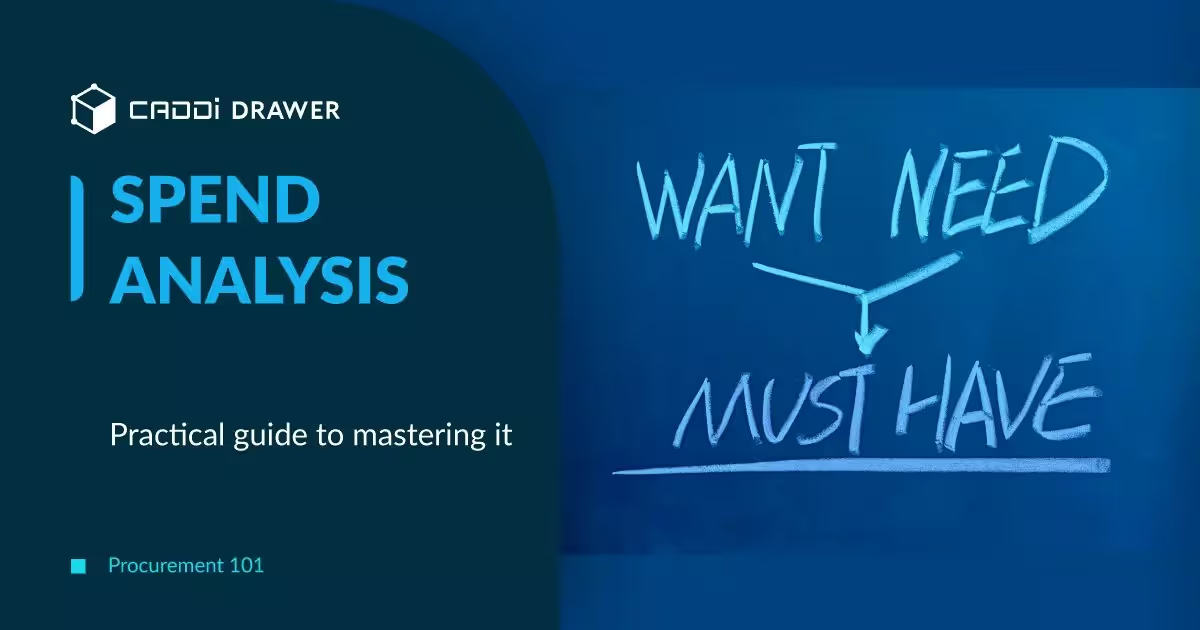



.svg)



.svg)
.svg)
.svg)


